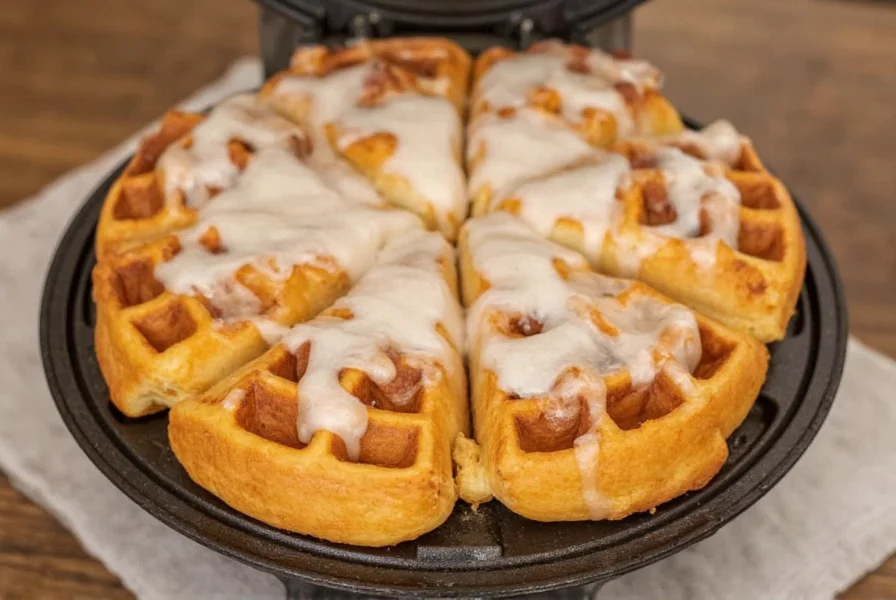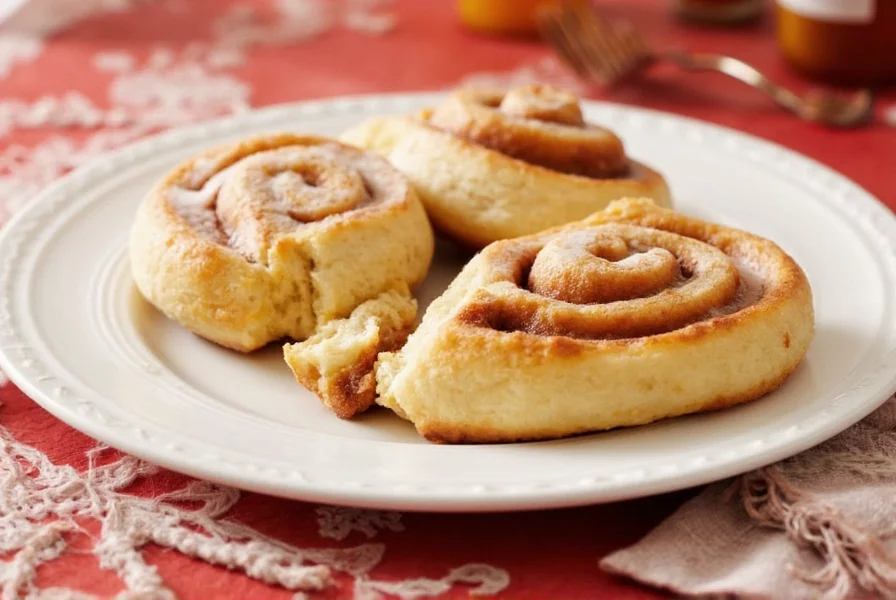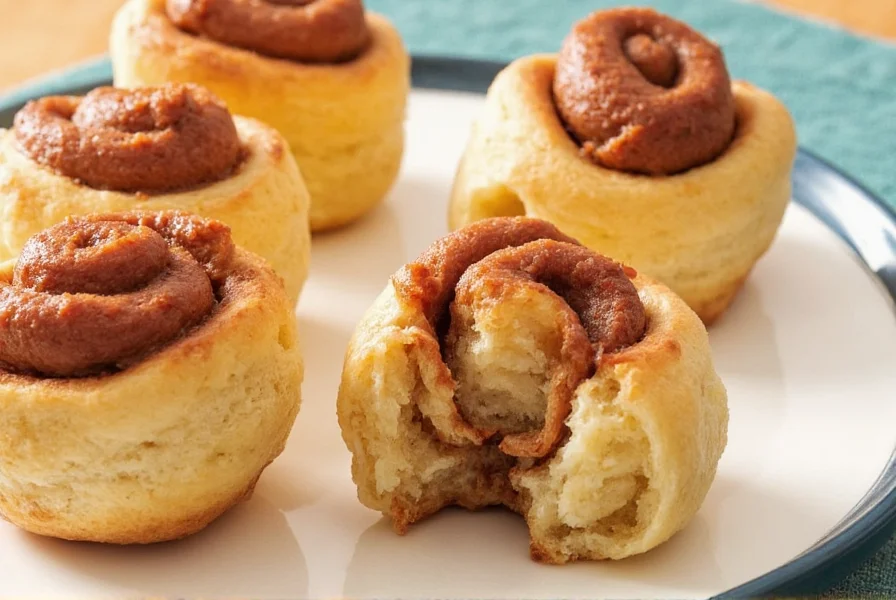The Waffle Maker Cinnamon Roll Advantage
Transforming your waffle maker into a cinnamon roll cooker offers several distinct benefits that home bakers appreciate. Unlike conventional baking methods, the waffle iron's direct heat contact creates an exceptional texture profile—crispy, caramelized edges surrounding a tender, pillowy interior. This technique typically cuts cooking time from 20-25 minutes in an oven down to just 8-12 minutes, making it ideal for busy mornings or unexpected guests.
Many home cooks discover that waffle maker cinnamon rolls develop a unique pocket structure that holds icing exceptionally well. The grid pattern creates natural wells for the sweet glaze to pool, ensuring every bite delivers that perfect cinnamon-icing combination. Plus, this method works wonderfully with both homemade and quality store-bought dough, offering flexibility for bakers of all skill levels.
Essential Equipment and Ingredients
Before you start your waffle iron cinnamon roll adventure, gather these essentials:
| Equipment | Ingredients |
|---|---|
| Standard or Belgian waffle maker | 1 can (16.3 oz) refrigerated cinnamon roll dough OR homemade dough |
| Non-stick cooking spray | 2 tablespoons melted butter |
| Silicone tongs or fork | Additional cinnamon-sugar mixture (optional) |
| Plate for serving | Cream cheese or vanilla icing |
For best results, use a waffle maker with adjustable temperature settings. Medium heat (around 375°F) works perfectly for most models. If using store-bought dough, Pillsbury Grands! cinnamon rolls yield excellent results in waffle makers due to their ideal size and consistency.

Step-by-Step Cooking Instructions
Follow these precise steps for waffle maker cinnamon roll perfection:
- Preheat your waffle maker to medium setting (approximately 375°F) and lightly coat the grids with non-stick spray
- Prepare the rolls - If using canned dough, separate rolls and optionally roll each in additional cinnamon-sugar mixture
- Place one roll in the center of the waffle iron (don't overcrowd - cook one at a time for standard makers)
- Cook for 3-4 minutes until steam stops and edges appear golden brown
- Check doneness by gently lifting edge with tongs - should feel firm but spring back when pressed
- Remove carefully and immediately brush with melted butter
- Drizzle with icing while still warm for maximum absorption
Timing varies slightly by waffle maker model and dough type. Belgian waffle makers may require 4-5 minutes per roll, while standard makers typically need 3-4 minutes. The key indicator is when steam stops escaping from the sides of the waffle iron.
Troubleshooting Common Issues
Even experienced waffle maker cinnamon roll enthusiasts encounter these common challenges:
- Sticking problems: Ensure adequate non-stick spray and proper preheating. Wait until steam stops before attempting removal.
- Undercooked centers: Reduce heat slightly and increase cooking time by 1-2 minutes. The dough should feel firm but yield slightly when pressed.
- Filling leakage: Don't overfill if making homemade rolls. For store-bought, avoid pressing down too hard when closing the waffle maker.
- Burning edges: Lower temperature setting and monitor closely during first cooking cycle to determine ideal timing for your specific appliance.
For best results with homemade cinnamon roll dough in waffle makers, slightly under-proof the dough before cooking. The direct heat will cause rapid expansion, and properly under-proofed dough yields the ideal texture without overflowing the waffle grids.
Serving Suggestions and Variations
Elevate your waffle maker cinnamon rolls with these professional tips:
- Drizzle with warm cream cheese icing immediately after cooking for maximum absorption
- Add a pinch of sea salt to the icing to balance the sweetness
- Top with toasted pecans or walnuts for added crunch
- Pair with a strong coffee or cold glass of milk to complement the rich flavors
- For special occasions, create a cinnamon roll waffle sandwich with cream cheese filling
Many bakers discover that waffle iron cinnamon rolls work exceptionally well with alternative doughs. Try using biscuit dough with added cinnamon filling for a heartier texture, or crescent roll dough for a flakier result. Gluten-free cinnamon roll dough also adapts well to the waffle maker method with slightly reduced cooking time.

Waffle Maker vs. Traditional Oven: Key Differences
Understanding the textural and timing differences helps set proper expectations:
- Cooking time: Waffle maker: 8-12 minutes vs. Oven: 20-25 minutes
- Texture profile: Waffle maker creates defined crispy edges with soft centers vs. oven's more uniform texture
- Heat distribution: Direct contact heat vs. ambient oven heat
- Icing absorption: Waffle maker's grid pattern creates natural wells for better icing retention
- Batch size: Typically one roll at a time vs. multiple rolls simultaneously in oven
The waffle maker method particularly shines when you need just one or two servings quickly. It's perfect for meal prepping individual portions that reheat beautifully in toaster ovens or air fryers throughout the week.
Frequently Asked Questions
Can I use frozen cinnamon roll dough in a waffle maker?
Yes, but thaw frozen cinnamon roll dough completely before using in a waffle maker. Partially frozen dough won't cook evenly and may stick to the grids. For best results, let dough reach room temperature for 30-60 minutes before cooking.
How do I prevent cinnamon rolls from sticking to the waffle maker?
Thoroughly preheat your waffle maker and apply generous non-stick cooking spray directly to the grids. Wait until steam stops escaping before attempting removal. Using melted butter on the cooked rolls immediately after removal also creates a natural non-stick barrier for serving.
Can I make homemade cinnamon roll dough for waffle makers?
Absolutely. When making homemade dough specifically for waffle makers, slightly reduce the yeast (by about 25%) and under-proof the dough. The direct heat causes rapid expansion, so properly under-proofed dough yields ideal texture without overflowing the waffle grids.
Do waffle maker cinnamon rolls taste different from oven-baked?
Yes, they develop a unique flavor profile. The direct heat creates caramelized edges that add a subtle toasty dimension while sealing in moisture. Many tasters describe waffle maker cinnamon rolls as having more complex flavor with better textural contrast between the crispy exterior and soft interior compared to uniformly textured oven-baked versions.
How many cinnamon rolls can I cook at once in a waffle maker?
Most standard waffle makers accommodate one cinnamon roll at a time. Larger Belgian-style makers might fit two smaller rolls, but overcrowding leads to uneven cooking and sticking. For best results, cook rolls individually to ensure proper heat distribution and prevent filling leakage between rolls.











 浙公网安备
33010002000092号
浙公网安备
33010002000092号 浙B2-20120091-4
浙B2-20120091-4